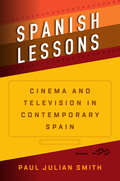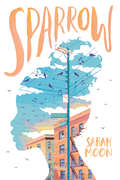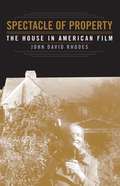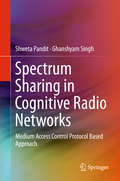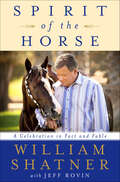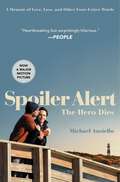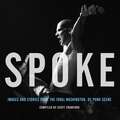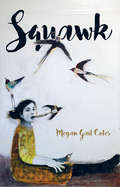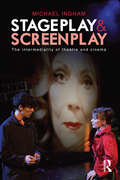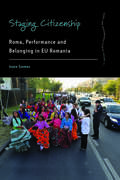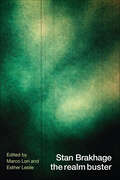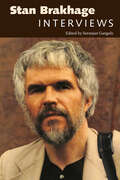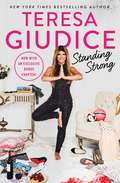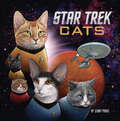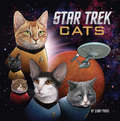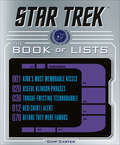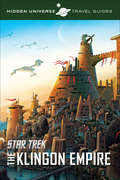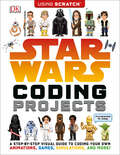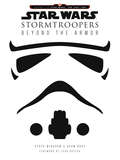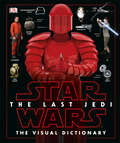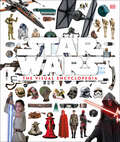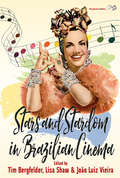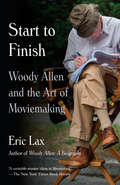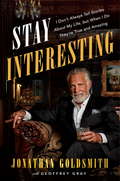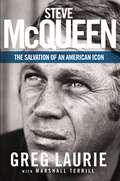- Table View
- List View
Spanish Lessons: Cinema and Television in Contemporary Spain
by Paul Julian SmithThough unjustly neglected by English-language audiences, Spanish film and television not only represent a remarkably influential and vibrant cultural industry; they are also a fertile site of innovation in the production of "transmedia" works that bridge narrative forms. In Spanish Lessons, Paul Julian Smith provides an engaging exploration of visual culture in an era of collapsing genre boundaries, accelerating technological change, and political-economic tumult. Whether generating new insights into the work of key figures like Pedro Almodóvar, comparing media depictions of Spain's economic woes, or giving long-overdue critical attention to quality television series, Smith's book is a consistently lively and accessible cultural investigation.
Sparrow (Arthur A Levine Novel Bks.)
by Sarah MoonThe story of a sensitive, gifted African American girl who tells us with mordant humor what it feels like to spend every day wishing so hard that you could fly away from it allSparrow has always had a difficult time making friends. She would always rather stay home on the weekends with her mother, an affluent IT executive at a Manhattan bank, reading, or watching the birds, than play with other kids. And that's made school a lonely experience for her. It's made LIFE a lonely experience.But when the one teacher who really understood her -- Mrs. Wexler, the school librarian, a woman who let her eat her lunch in the library office rather than hide in a bathroom stall, a woman who shared her passion for novels and knew just the ones she'd love -- is killed in a freak car accident, Sparrow's world unravels and she's found on the roof of her school in an apparent suicide attempt.With the help of an insightful therapist, Sparrow finally reveals the truth of her inner life. And it's here that she discovers an outlet in rock & roll music...
Spectacle of Property: The House in American Film
by John David RhodesMuch of our time at the movies is spent in other people&’s homes. Cinema is, after all, often about everyday life. Spectacle of Property is the first book to address the question of the ubiquitous conjuncture of the moving image and its domestic architecture. Arguing that in cinema we pay to occupy spaces we cannot occupy, John David Rhodes explores how the house in cinema both structures and criticizes fantasies of property and ownership.Rhodes tells the story of the ambivalent but powerful pleasure we take in looking at private property onscreen, analyzing the security and ease the house promises along with the horrible anxieties it produces. He begins by laying out a theory of film spectatorship that proposes the concept of the &“spectator-tenant,&” with reference to films such as Gone with the Wind and The Magnificent Ambersons. The book continues with three chapters that are each occupied with a different architectural style and the films that make use of it: the bungalow, the modernist house, and the shingle style house. Rhodes considers a variety of canonical films rarely analyzed side by side, such as Psycho in relation to Grey Gardens and Meet Me in St. Louis. Among the other films discussed are Meshes of the Afternoon, Mildred Pierce, A Star Is Born, Killer of Sheep, and A Single Man.Bringing together film history, film theory, and architectural history as no book has to date, Spectacle of Property marks a new milestone in examining cinema&’s relationship to realism while leaving us vastly more informed about, if less at home inside, the houses we occupy at the movies.
Spectrum Sharing in Cognitive Radio Networks
by Ghanshyam Singh Shweta PanditThis book discusses the use of the spectrum sharing techniques in cognitive radio technology, in order to address the problem of spectrum scarcity for future wireless communications. The authors describe a cognitive radio medium access control (MAC) protocol, with which throughput maximization has been achieved. The discussion also includes use of this MAC protocol for imperfect sensing scenarios and its effect on the performance of cognitive radio systems. The authors also discuss how energy efficiency has been maximized in this system, by applying a simple algorithm for optimizing the transmit power of the cognitive user. The study about the channel fading in the cognitive user and licensed user and power adaption policy in this scenario under peak transmit power and interference power constraint is also present in this book.
Spirit of the Horse: A Celebration in Fact and Fable
by William Shatner Jeff Rovin“Shatner (and some other pretty great writers!) share some of the greatest horse tales ever told.” ―Carson Kressley, Emmy-winning TV personality, New York Times–bestselling author, and World Champion HorsemanFrom his first time riding as a child, William Shatner has felt a deep love for horses. Whether seated in the saddle, communicating with them, or simply appreciating their beauty, his bond with these majestic animals is deep. For decades he has sought to share his joy—with children, veterans, those with disabilities, and many more—through his annual Hollywood Charity Horse Show. And here, he brings that same joy to his fans and readers.In Spirit of the Horse, the Star Trek and Boston Legal legend speaks from the heart about the remarkable effect horses have had on his life and on the lives of others. From his first horse, bought impulsively on the advice of a twelve-year-old, to his favorite horses, acquired after many years of learning what to look for, this book draws from Shatner’s own experience and pairs it with a wealth of classic horse stories, including unique retellings of the Pegasus myth and the feats of the most famous war horses throughout history. The result is a celebration that captures the unparalleled connection between humans and horses—and the power, courage, mindfulness, and healing that they can inspire in us.Many fans have heard about Shatner’s passion for horses; few have seen it revealed as completely as it is here.“From the first words of Spirit of the Horse, it's clear that this is a man who is wonderfully, hopelessly in love with the creatures.” —NPR
Spoiler Alert: A Memoir of Love, Loss, and Other Four-Letter Words
by Michael AusielloIn this evocative and gorgeously wrought memoir reminiscent of Rob Sheffield’s Love Is a Mixtape and George Hodgman’s Bettyville, Michael Ausiello—a respected TV columnist and founder and editor-in-chief of TVLine.com—remembers his late husband, and the lessons, love, and laughter that they shared throughout their fourteen years together.For the past decade, TV fans of all stripes have counted upon Michael Ausiello’s insider knowledge to get the scoop on their favorite shows and stars. From his time at Soaps in Depth to his influential stints at TV Guide and Entertainment Weekly to his current role as founder and editor-in-chief of the wildly popular website TVLine.com, Michael has established himself as the go-to expert when it comes to our most popular form of entertainment. What many of his fans don’t know, however, is that while his professional life was in full swing, Michael had to endure the greatest of personal tragedies: his husband, Kit Cowan, was diagnosed with a rare and very aggressive form of neuroendocrine cancer. Over the course of eleven months, Kit and Michael did their best to combat the deadly disease, but Kit succumbed to his illness in February 2015. In this heartbreaking and darkly hilarious memoir, Michael tells the story of his harrowing and challenging last year with Kit while revisiting the thirteen years that preceded it, and how the undeniably powerful bond between him and Kit carried them through all manner of difficulty—always with laughter front and center in their relationship. Instead of a tale of sadness and loss, Spoiler Alert: The Hero Dies is an unforgettable, inspiring, and beautiful testament to the resilience and strength of true love.
Spoke: Images and Stories from the 1980s Washington, DC Punk Scene
by Scott Crawford"The pictures, which include some posed portraits but are mostly concert shots, are the chief attraction. They freeze moments of adolescent release, vein-bulging intensity and sweaty communion that fuses performer and audience...Vivid and evocative."--Washington Post"Scott Crawford, the man behind the acclaimed documentary Salad Days, has given us another taste of the best-kept secret of 80s in his new book Spoke: Washington DC’s hardcore punk scene."--Dazed"With music by Minor Threat, Void, Rites of Spring, Government Issue, and many others propelling the story of hardscrabble, Reagan-era D.C. as the hotbed for a new artistic outlet in Salad Days, Crawford saw the book as a way to scoop up important narrative from the cutting-room floor and find a new home for it."--Fast Company"Pockmarked with burned-out buildings and boarded-over storefronts, Northwest DC was once home to a vibrant and sometimes violent punk movement beginning in the early 1980s. For geeky 12-year-old Scott Crawford, that changed everything: He chucked comic books for punk rock and self-published a music zine from his mother’s kitchen table in Silver Spring. This month, Crawford releases a book about those days, Spoke--a companion to his 2014 documentary, Salad Days--featuring stories from local players such as Dave Grohl, Henry Rollins, and Ian MacKaye."--Washingtonian Magazine"Spoke...adroitly uses both photographs and oral histories to capture the importance of what can best be described as a cultural revolution within the nation’s capital."--Shepherd Express"This coffee table version of the documentary [Salad Days] follows the D.C. scene’s often politically-charged brand of punk rock, from Bad Brains to Jawbox, and of course the legendary Fugazi. And there’s even the near-forgotten SOA, whose frontman Henry Rollins took his D.C. energy to L.A. where he stepped in as the singer for Black Flag."--Yellow Scene Magazine"A must-have for any rock historian or pop-culture buff...The perfect punk coffee table book."--Shockwave Magazine"Highly recommended...A must read for punk fans."--Chorus.fm/HiFiNoise"A worthy addition to the growing amount of literature on the American hardcore/punk scene, Spoke will look great on any aging punks’ coffee table as a document to a vital, electric time."--Ink19.com"A forthright testament to a kaleidoscopic community. This is a rounded collection, with surprises on every page...It’s collection that rocks."--Shelf Awareness for ReadersThe Washington, DC punk music scene of the 1980s gave birth to influential bands like Bad Brains, Minor Threat, and Fugazi. Here that era is portrayed in its purest form: an oral history by the creators themselves, including nearly two hundred photographs capturing the power and spirit of this politically progressive corner of American underground music. This stunning and intimate collection features rare images from Jim Saah, Cynthia Connolly, Bert Queiroz, and many others who documented this vibrant community. Compiled by Scott Crawford-whose critically acclaimed film Salad Days provided an unprecedented exploration into the 1980s DC punk scene-Spoke delves deeper into one of the most dynamic movements in US music history.Featuring: BAD BRAINS, THE TEEN IDLES, BLACK MARKET BABY, SOA, MINOR THREAT, GOVERNMENT ISSUE, VOID, IRON CROSS, THE FAITH, SCREAM, MARGINAL MAN, GRAY MATTER, BEEFEATER, KING FACE, RITES OF SPRING, DAG NASTY, EMBRACE, SOULSIDE, FIRE PARTY, SHUDDER TO THINK, IGNITION, FUGAZI, SWIZ, THE NATION OF ULYSSES, and JAWBOX.
Squawk
by Megan Gail ColesAnnie Runningbird doesn’t have time for the games boys want her to play. She’s aging out of foster care on her next birthday. The system has decided she is an adult, so Annie must make adult decisions. Where will she live? How will she make money? Demanding grown-up choices preoccupy the young girl’s mind as she navigates relationships with boys and men in her company. Does she like Isaac, a cute yet naive boy she met at the mall food court? Can she trust Louis, her older and increasingly overbearing foster care worker? Who can Annie depend on in her ever-shifting world? This intel is important. Because Annie needs to win the very real game she’s playing. She must save herself to save the day.
Stage-Play and Screen-Play: The intermediality of theatre and cinema
by Michael InghamDialogue between film and theatre studies is frequently hampered by the lack of a shared vocabulary. Stage-Play and Screen-Play sets out to remedy this, mapping out an intermedial space in which both film and theatre might be examined. Each chapter’s evaluation of the processes and products of stage-to-screen and screen-to-stage transfer is grounded in relevant, applied contexts. Michael Ingham draws upon the growing field of adaptation studies to present case studies ranging from Martin McDonagh’s The Cripple of Inishmaan and RSC Live’s simulcast of Richard II to F.W. Murnau’s silent Tartüff, Peter Bogdanovich’s film adaptation of Michael Frayn’s Noises Off, and Akiro Kurosawa’s Ran, highlighting the multiple interfaces between media. Offering a fresh insight into the ways in which film and theatre communicate dramatic performances, this volume is a must-read for students and scholars of stage and screen.
Staging Citizenship: Roma, Performance and Belonging in EU Romania (Dance and Performance Studies #11)
by Ioana SzemanBased on over a decade of fieldwork conducted with urban Roma, Staging Citizenship offers a powerful new perspective on one of the European Union’s most marginal and disenfranchised communities. Focusing on “performance” broadly conceived, it follows members of a squatter’s settlement in Transylvania as they navigate precarious circumstances in a postsocialist state. Through accounts of music and dance performances, media representations, activism, and interactions with both non-governmental organizations and state agencies, author Ioana Szeman grounds broad themes of political economy, citizenship, resistance, and neoliberalism in her subjects’ remarkably varied lives and experiences.
Stan Brakhage the realm buster
by Marco Lori and Esther LeslieStan Brakhage's body of work counts as one of the most important within post-war avant-garde cinema, and yet it has rarely been given the attention it deserves. Over the years, though, diverse and original reflections have developed, distancing his figure little by little from critical categories. This collection of newly commissioned essays, plus some important reprinted work, queries some of the consensus on Brakhage's films. In particular, many of these essays revolve around the controversial issues of representation and perception.This project sets out from the assumption that Brakhage's art is articulated primarily through opposing tensions, which donate his figure and films an extraordinary depth, even as they evince fleetingness, elusivity and paradoxicality. This collection aims not only to clarify aspects of Brakhage's art, but also to show how his work is involved in a constant mediation between antinomies and opposites. At the same time, his art presents a multifaceted object endlessly posing new questions to the viewer, for which no point of entry or perspective is preferred in respect to the others. Acknowledging this, this volume hopes that the experience of his films will be revitalised.Featuring topics as diverse as the technical and semantic ambiguity of blacks, the fissures in mimetic representation of the 'it' within the 'itself' of an image, the film-maker as practical psychologist through cognitive theories, the critique of ocularcentrism by mingling sight with other senses such as touch, films that can actually philosophise in a Wittgensteinian way, political guilt and collusion in aesthetic forms, a disjunctive, reflexive, and phenomenological temporality realising Deleuze's image-time, and the echoes of Ezra Pound and pneumophantasmology in the quest of art as spiritual revelation; this book addresses not only scholars, but also is a thorough and thought-provoking introduction for the uninitiated. Contributors include: Nicky Hamlyn, Peter Mudie, Paul Taberham, Gareth Evans, Rebecca A. Sheehan, Christina Chalmers, Stephen Mooney and Marco Lori.
Stan Brakhage: Interviews (Conversations with Filmmakers Series)
by Suranjan GangulyIn this volume, editor Suranjan Ganguly collects nine of Stan Brakhage’s most important interviews in which the filmmaker describes his conceptual frameworks; his theories of vision and sound; the importance of poetry, music, and the visual arts in relation to his work; his concept of the muse; and the key influences on his art-making. In doing so, Brakhage (1933–2003) discusses some of his iconic films, such as Anticipation of the Night, Dog Star Man, Scenes from Under Childhood, Mothlight, and The Text of Light.One of the most innovative filmmakers in the history of experimental cinema, Brakhage made almost 350 films in his fifty-two-year-long career. These films include psychodramas, autobiography, Freudian trance films, birth films, song cycles, meditations on light, and hand-painted films, which range from nine seconds to over four hours in duration. Born in Kansas City, Missouri, he lived most of his life in the mountains of Colorado, teaching for twenty-one years in the film studies program at the University of Colorado, Boulder.As a filmmaker, Brakhage’s life-long obsession with what he called an “adventure in perception” made him focus on the act of seeing itself, which he tried to capture on film in multiple ways both with and without his camera and by scratching and painting on film. Convinced that there is a primary level of cognition that precedes language, he wrote of the “untutored eye” with which children can access ineffable visual realities. Adults, who have lost such primal sight, can “retrain” their eyes by becoming conscious of what constitutes true vision and the different ways in which they daily perceive the world. Brakhage’s films experiment with such perceptions, manipulating visual and auditory experience in ways that continue to influence film today.
Standing Strong
by Teresa GiudiceThe Real Housewives of New Jersey star and New York Times bestselling author Teresa Giudice opens up about her tumultuous past year in her emotional new memoir Standing Strong.In her second memoir, Teresa chronicles her life since her release from prison and what it’s been like to weather difficult times as a single mother. Though she recounts the happy memories she has experienced over the past year, she also touches upon some of the darkest times of her life, including her parents' hospitalizations for severe medical issues in late 2016, which led to the tragic passing of her mother in March of 2017. With unparalleled honesty and courage, Teresa opens up in Standing Strong in ways she never has before, showing her fans what it truly means to be a survivor.
Star Trek Cats
by Jenny ParksA collection of illustrated classic Star Trek scenes starring an adorable cast of cats. Captain&’s log: We have entered a galaxy where beloved illustrator Jenny Parks has conjured an astonishingly vivid homage to the original Star Trek series with an unexpected twist: a cast of cats. Featuring a hilarious new take on iconic characters and scenes—from Kirk in the Captain&’s chair to Spock offering his Vulcan wisdom—this eye-opening adventure stays true to the tone of the classic TV show. Playful, loving, and from a strange new world, Star Trek Cats is the perfect gift for fans of, well, Star Trek and cats. TM & © 2017 CBS Studios Inc. STAR TREK and related marks and logos are trademarks of CBS Studios Inc. All Rights Reserved. Praise for Star Trek Cats&“Is it too early to state that this book is possibly the quintessential Christmas stocking filler for the lover of Star Trek AND cats in your family?&” —Starburst &“Featuring big, bold artistic interpretations of many a famous Star Trek scene, except with, well, uh, cats, the book is rewarding for both an episode-quoting Trekkie and your favorite crazy cat lover. And if you happen to be both of those things, it's most certainly an item you will want to add to your collection.&” —TrekCore &“Jenny Parks is a great illustrator. The way she has captured the characters and a variety of our favorite aliens while making them inhabit very feline traits is superb and delivers a many good laughs. If you like things on the quirky and fun side, you'll want this book.&” —GeekDad
Star Trek Cats (Twin Pins Ser.)
by Jenny ParksCaptain's log: We have entered a galaxy where beloved illustrator Jenny Parks has conjured an astonishingly vivid homage to the original Star Trek series with an unexpected twist: a cast of cats. Featuring a hilarious new take on iconic characters and scenes—from Kirk in the Captain's chair to Spock offering his Vulcan wisdom—this eye-opening adventure stays true to the tone of the classic TV show. Playful, loving, and from a strange new world, Star Trek Cats is the perfect gift for fans of, well, Star Trek and cats.TM & © 2017 CBS Studios Inc. STAR TREK and related marks and logos are trademarks of CBS Studios Inc. All Rights Reserved.
Star Trek: The Book of Lists
by Chip CarterSpanning the epic science fiction franchise’s fifty-one-year history, a breathtaking collection of the most compelling Star Trek facts and trivia, including events from both on and off-screen, available in 100 concise lists.Since Gene Roddenberry’s original series first aired in 1966, Star Trek has become a pop culture phenomenon, and one of the largest global properties of all time. Entertaining and fun, Star Trek: The Book of Lists catalogs the most compelling facts about the original series and its spin-offs, as well as its thirteen films, gathered together and broken down into one hundred lists, including:Historical Figure CameosCrew CrossoversMemorable DeathsIntergalactic Threats, Enemies, and VillainsCompiling a galaxy's worth of information in one handy digest, Star Trek: The Book of Lists is a fascinating historical record of the Star Trek universe for both hardcore fans and causal viewers.
Star Trek: The Klingon Empire (Hidden Universe Travel Guides)
by Insight EditionsExplore the homeworld and vast dominion of Star Trek&’s formidable Klingons in this &“fun and engaging&” travel guide full of &“fascinating facts&”(Starburst Magazine). nuqneH! Bored of standard vacations to places like Risa or Wrigley&’s Pleasure Planet? Want to discover a unique and ancient culture not bound by standard niceties and social mores? Then Qo&’noS and the vast Klingon Empire are for you! This one-of-a-kind travel guide will give you all the information you need to plan, enjoy, and survive your trip to the very heart of Klingon territory, from an overview of Klingon history to tips on what to wear (fur and leather are very popular) to a glossary of important phrases like &“mamI' DaneH'a'? nItebHa' mamI' DaneH'a'?&” (Would you like to dance with me?). Every major location in the Klingon Empire is covered in depth, with tips on where to eat (you&’ve not lived until you&’ve eaten Klingon skull stew), how best to get to and from your chosen destination, and what to do if you find yourself challenged to a bat&’leth battle to the death. Locations include the homeworld Qo&’noS and its famous locales such as the First City, the Caves of No&’mat, the Hamar Mountains, and the city of Krennla, plus neighboring moons Corvix and Praxis, and many, many more must-see areas. The book also features exclusive maps and illustrations that bring to life the Klingon Empire and form the perfect reference guide for any visitor. So what are you waiting for? Qapla&’!
Star Wars Coding Projects: A Step-by-Step Visual Guide to Coding Your Own Animations, Games, Simulations an
by Jon WoodcockLearn to design and code games using Scratch, inspired by the Star Wars™ universe!Star Wars Coding Projects is a step-by-step visual guide to designing and coding in Scratch. The setting is as big as your imagination. Your favorite Star Wars characters will guide you through fun projects, animations, and games as you learn how to create and code. Draw your own Star Wars inspired sprites to use in the projects. You're the director as you navigate the spaceship you've designed through the asteroid belt you imagined as you go on the jetpack adventures you brought to life. Learn essential coding skills, share the sprites you drew with friends, and even challenge your pals to beat your high scores in the games you designed. Each project lists the sprites you'll have fun creating through simple, numbered steps that are fully illustrated and easy to follow. Coding games have never been so fun, with Star Wars characters to guide you.© & TM 2017 LUCASFILM LTD.
Star Wars Stormtroopers: Beyond the Armor
by Ryder Windham Adam BrayJust in time for the next blockbuster, Star Wars: The Last Jedi, this unique and beautifully designed compendium with removable features traces one of the franchise’s most iconic characters—the stormtrooper—from initial development through all nine Star Wars movies to their many iterations in TV, comics, videogames, novels, and pop-culture. Star Wars: A New Hope, the very first installment in the beloved science-fiction series, introduced the Imperial stormtroopers—the army of the fearsome and tyrannical Galactic Empire. Charged with establishing Imperial authority and suppressing resistance, these terrifying, faceless, well-disciplined soldiers in white have become a universal symbol of oppression. Star Wars Stormtroopers explores these striking warriors and their evolution in depth for the first time. Ryder Windham and Adam Bray trace the roots of their creation and design, and explore how these elite troops from a galaxy far, far away have been depicted in movies, cartoons, comics, novels, and merchandizing. Filled with photographs, illustrations, story boards, and other artwork, this lavish officially licensed book comes complete with removable features, including posters, stickers, replica memorabilia and more, making it an essential keepsake for every Star Wars fan, as well as military, design, and film aficionados.
Star Wars The Last Jedi™ The Visual Dictionary
by Pablo HidalgoStar Wars: The Last Jedi™: The Visual Dictionary is the definitive guide to Star Wars: The Last Jedi, revealing the characters, creatures, droids, locations, and technology from the new film. Packed with 100+ images and information as penned by Star Wars™ scribe Pablo Hidalgo, it's a must-have for all fans who want to go beyond the movie experience.© & TM 2017 LUCASFILM LTD.
Star Wars: The Visual Encyclopedia
by Adam Bray Cole Horton Tricia BarrCovering more than 2,500 characters, creatures, planets, vehicles, Droids™, weapons, technology, and more from the Star Wars™ universe, this visual tour is the ultimate compendium for the epic saga and beyond.Take a stunning visual tour of Star Wars with DK's comprehensive pictorial guide to the galaxy far, far away!From lightsabers to beasts to food and clothing, Star Wars: The Visual Encyclopedia is a virtual museum in a book. Explore beautiful galleries with more than 2,500 images, and discover facts about Star Wars culture, science, and geography.With a full history of the galactic politics, the Jedi Council, and the Empire, Star Wars: The Visual Encyclopedia walks fans through the entire timeline of Star Wars. See the blasters of Star Wars: Episode IV A New Hope™, look at the stormtroopers of Star Wars: The Force Awakens™, and study the geography of Rogue One: A Star Wars Story™.Each section of the book focuses on different topics to dedicate special attention and detail to every part of the universe, no matter how small. From the planets in the outer rim to Padmé's bridal wear, nothing is missed.A celebration of all things Star Wars, this compendium is the perfect addition to any fan's bookshelf.© & TM 2017 LUCASFILM LTD. Used Under Authorization.
Stars and Stardom in Brazilian Cinema
by Lisa Shaw Tim Bergfelder João Luiz VieiraDespite the recent explosion of scholarly interest in "star studies," Brazilian film has received comparatively little attention. As this volume demonstrates, however, the richness of Brazilian stardom extends well beyond the ubiquitous Carmen Miranda. Among the studies assembled here are fascinating explorations of figures such as Eliane Lage (the star attraction of São Paulo's Vera Cruz studios), cult horror movie auteur Coffin Joe, and Lázaro Ramos, the most visible Afro-Brazilian actor today. At the same time, contributors interrogate the inner workings of the star system in Brazil, from the pioneering efforts of silent-era actresses to the recent advent of the non-professional movie star.
Start to Finish: Woody Allen and the Art of Moviemaking
by Eric LaxA cinephile's dream: the chance to follow legendary director Woody Allen throughout the creation of a film--from inception to premiere--and to enjoy his reflections on some of the finest artists in the history of cinema. Eric Lax has been with Woody Allen almost every step of the way. He chronicled Allen's transformation from stand-up comedian to filmmaker in On Being Funny (1975). His international best seller, Woody Allen: A Biography (1991), was a portrait of a director hitting his stride. Conversations with Woody Allen comprised interviews that illustrated Allen's evolution from 1971 to 2008. Now, Lax invites us onto the set--and even further behind the scenes--of Allen's Irrational Man, which was released in 2015, and starred Joaquin Phoenix and Emma Stone. Revealing the intimate details of Allen's filmmaking process, Lax shows us the screenplay being shaped, the scenes being prepared, the actors, cinematographers, other crew members, the editors, all engaged in their work. We hear Allen's colleagues speak candidly about working with him, and Allen speaking with equal openness about his lifetime's work. An unprecedented revelation of one of the foremost filmmakers of our time, Start to Finish is sure to delight not only movie buffs and Allen fans, but everyone who has marveled at the seeming magic of the artistic process.
Stay Interesting: I Don't Always Tell Stories About My Life, but When I Do They're True and Amazing
by Jonathan GoldsmithWhat makes a life truly interesting? Is it the people you meet? The risks you take? The adventures you remember?Jonathan Goldsmith has many answers to that question. For years he was a struggling actor in New York and Los Angeles, with experiences that included competing for roles with Dustin Hoffman, getting shot by John Wayne, drinking with Tennessee Williams, and sailing the high seas with Fernando Lamas, never mind romancing many lovely ladies along the way.However, it wasn’t all fun and games for Jonathan. Frustrated with his career, he left Hollywood for other adventures in business and life. But then, a fascinating opportunity came his way—a chance to star in a new campaign for Dos Equis beer. A role he was sure he wasn’t right for, but he gave it a shot all the same. Which led to the role that would bring him the success that had so long eluded him—that of “The Most Interesting Man in the World.”A memoir told through a series of adventures and the lessons he’s learned and wants to pass on, Stay Interesting is a truly daring and bold tale, and a manifesto about taking chances, not giving up, making courageous choices, and living a truly adventurous, and always interesting life.
Steve McQueen: The Salvation of an American Icon
by Greg LaurieJoin Greg Laurie as he takes a cross-country drive in his 1968 Highland Green Ford Mustang 390 GT through the canyons of Malibu, the alleys of Hollywood, the wide and open roads of the Midwest, and the streets of New York as he traces the woolly geography of actor Steve McQueen's life, relationships, career, and spiritual journey. This iconic muscle car was the vehicle McQueen drove in his most raucous and enduring film, Bullitt. In the 1960s, McQueen was, according to box office receipts, the biggest movie star of his generation and one of the coolest men to ever walk the planet. Greg Laurie was a teen at the time and an ardent fan of "The King of Cool," first mesmerized by McQueen in 1963's The Great Escape. Like millions of cinema fans, Greg developed a lifelong fascination with the actor. Now he has a chance to tell McQueen's story. McQueen was a complex, contradictory man who lived the same way he drove his motorcycles and cars: fearlessly, ruthlessly and at top speed. After a lifetime of fast cars, women, and drugs, McQueen took a surprising detour. In this book, Laurie thoughtfully interviews Steve McQueen's friends, co-stars, associates, widow, and pastor to tell of the dramatic life-change for the actor in the spring of 1979 - six months before McQueen was diagnosed with terminal cancer. What were the critical steps that led McQueen to make such a life-altering decision? Perhaps more importantly, why is that part of his story so rarely told? This book answers these questions. Greg Laurie will follow the seeds of Christianity that were sown throughout McQueen's improbable life where a Light finally shone into the darkness of his troubled life. These seeds miraculously germinated, allowing McQueen to see that redemption through Jesus Christ is a lasting truth more glittering and real than any magic of the entertainment industry.
